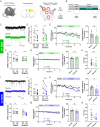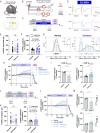TAAR1 agonist ulotaront modulates striatal and hippocampal glutamate function in a state-dependent manner
- PMID: 38110609
- PMCID: PMC11109157
- DOI: 10.1038/s41386-023-01779-x
TAAR1 agonist ulotaront modulates striatal and hippocampal glutamate function in a state-dependent manner
Abstract
Aberrant dopaminergic and glutamatergic function, particularly within the striatum and hippocampus, has repeatedly been associated with the pathophysiology of schizophrenia. Supported by preclinical and recent clinical data, trace amine-associated receptor 1 (TAAR1) agonism has emerged as a potential new treatment approach for schizophrenia. While current evidence implicates TAAR1-mediated regulation of dopaminergic tone as the primary circuit mechanism, little is known about the effects of TAAR1 agonists on the glutamatergic system and excitation-inhibition balance. Here we assessed the impact of ulotaront (SEP-363856), a TAAR1 agonist in Phase III clinical development for schizophrenia, on glutamate function in the mouse striatum and hippocampus. Ulotaront reduced spontaneous glutamatergic synaptic transmission and neuronal firing in striatal and hippocampal brain slices, respectively. Interestingly, ulotaront potentiated electrically-evoked excitatory synaptic transmission in both brain regions, suggesting the ability to modulate glutamatergic signaling in a state-dependent manner. Similar striatal effects were also observed with the TAAR1 agonist, RO5166017. Furthermore, we show that ulotaront regulates excitation-inhibition balance in the striatum by specifically modulating glutamatergic, but not GABAergic, spontaneous synaptic events. These findings expand the mechanistic circuit hypothesis of ulotaront and TAAR1 agonists, which may be uniquely positioned to normalize both the excessive dopaminergic tone and regulate abnormal glutamatergic function associated with schizophrenia.
© 2023. The Author(s).
Conflict of interest statement
SMY, SCH, KSK, LJB and ND are employees of Sumitomo Pharma America, Inc. (formerly Sunovion Pharmaceuticals). AG was an employee of Sunovion Pharmaceuticals Inc. at the time of the study. JH, FG, RT are employees of Neuroservices Alliance. SAN is an employee of Neurexpert Limited.
Figures





Similar articles
-
Modulation by Trace Amine-Associated Receptor 1 of Experimental Parkinsonism, L-DOPA Responsivity, and Glutamatergic Neurotransmission.J Neurosci. 2015 Oct 14;35(41):14057-69. doi: 10.1523/JNEUROSCI.1312-15.2015. J Neurosci. 2015. PMID: 26468205 Free PMC article.
-
Therapeutic Potential of TAAR1 Agonists in Schizophrenia: Evidence from Preclinical Models and Clinical Studies.Int J Mol Sci. 2021 Dec 7;22(24):13185. doi: 10.3390/ijms222413185. Int J Mol Sci. 2021. PMID: 34947997 Free PMC article. Review.
-
Ulotaront: A TAAR1 Agonist for the Treatment of Schizophrenia.ACS Med Chem Lett. 2021 Dec 6;13(1):92-98. doi: 10.1021/acsmedchemlett.1c00527. eCollection 2022 Jan 13. ACS Med Chem Lett. 2021. PMID: 35047111 Free PMC article.
-
Regulation by Trace Amine-Associated Receptor 1 (TAAR1) of Dopaminergic-GABAergic Interaction in the Striatum: Effects of the Enhancer Drug (-)BPAP.Neurochem Res. 2025 Feb 4;50(2):94. doi: 10.1007/s11064-025-04337-7. Neurochem Res. 2025. PMID: 39903411 Free PMC article.
-
Trace amine-associated receptor 1 (TAAR1) agonism for psychosis: a living systematic review and meta-analysis of human and non-human data.Wellcome Open Res. 2024 Apr 11;9:182. doi: 10.12688/wellcomeopenres.21302.1. eCollection 2024. Wellcome Open Res. 2024. PMID: 39036710 Free PMC article.
Cited by
-
Whole transcriptome sequencing to uncover CircRNA expression patterns linked to schizophrenia pathogenesis.Eur J Med Res. 2025 Jul 15;30(1):626. doi: 10.1186/s40001-025-02899-4. Eur J Med Res. 2025. PMID: 40665444 Free PMC article.
-
Understanding the Therapeutic Action of Antipsychotics: From Molecular to Cellular Targets With Focus on the Islands of Calleja.Int J Neuropsychopharmacol. 2024 Apr 1;27(4):pyae018. doi: 10.1093/ijnp/pyae018. Int J Neuropsychopharmacol. 2024. PMID: 38629703 Free PMC article. Review.
-
Computational Methods for the Discovery and Optimization of TAAR1 and TAAR5 Ligands.Int J Mol Sci. 2024 Jul 27;25(15):8226. doi: 10.3390/ijms25158226. Int J Mol Sci. 2024. PMID: 39125796 Free PMC article. Review.
-
Trace amine-associated receptors (TAARs)2-9 knockout mice exhibit reduced wakefulness and disrupted REM sleep.Front Psychiatry. 2025 Jan 29;15:1467964. doi: 10.3389/fpsyt.2024.1467964. eCollection 2024. Front Psychiatry. 2025. PMID: 39944134 Free PMC article.
References
MeSH terms
Substances
LinkOut - more resources
Full Text Sources
Other Literature Sources

